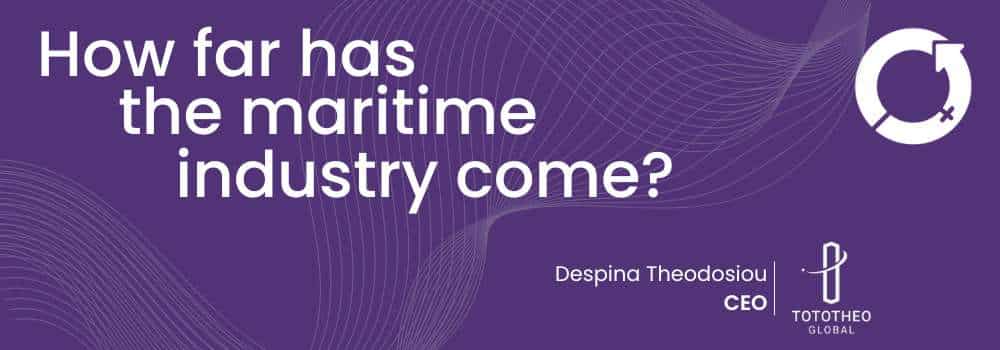Changing Course
Share this blog
Latest Maritime Vacancies
Global HR Director – Europe
Claims & Insurance Manager (Part-time) – London
Legal Counsel (Marine Operations) – London
Insurance Executive – Singapore
Operational and Commercial Pricing Analyst- London
IWD25 – How is the industry doing?

This International Women’s Day, we’re spotlighting the voices of CEOs, Directors, and Executive Leaders as they share their insights on the evolving maritime industry. With women still making up only around 30% of the workforce, progress toward gender equality continues—but there’s more to be done. We spoke with industry trailblazers about the initiatives in place to support women, the changes still needed to achieve true gender parity, and how the industry is adapting to attract and retain female talent.
Join us as we hear from Despina Theodosiou, Chief Executive Officer at Tototheo Global, on her perspective and experiences in shaping a more inclusive maritime sector.
How has the maritime industry changed when it comes to the attraction and retention of women in the sector?
In recent years, awareness around gender diversity has grown, and we are seeing more structured efforts to bring women into the sector. Companies and organisations have introduced targeted initiatives, such as mentorship programmes, leadership training, and networking opportunities, to support women’s career progression. The increasing presence of women in decision-making positions is also helping to challenge long-standing stereotypes and create a more inclusive industry culture.
Retention is showing positive signs of improvement, with more flexible work policies and a stronger focus on work-life balance, adapted to the realities of a maritime career, particularly in shore-based roles. At sea, challenges remain, but there is a growing commitment to improving working conditions, safety, and career development pathways, helping to encourage more women to stay in the profession.
Industry-wide campaigns, such as the IMO’s “Women in Maritime” initiatives, have also played a major role in raising visibility and accelerating change.
While progress is evident, the focus must remain on long-term, systemic change. Attracting women is one step—ensuring they are supported, valued, and given equal opportunities to advance is what will define real progress.
Have you put any practices in place to support women and their progression into leadership/advancement within their career?
Throughout my career, I have actively supported women’s progression into leadership and career advancement, both within my organisation and across the broader industry.
One of the key milestones in this effort was during my tenure as President of WISTA International,when, alongside a fantastic team and the collective efforts of national WISTA Associations, we successfully secured consultative status for WISTA at the International Maritime Organization (IMO). This was a pivotal achievement, strengthening women’s representation at the highest regulatory level and enabling WISTA to actively contribute to policy discussions and advocate for gender diversity in global maritime leadership. Today, as an observer and regular member, I take great pride in seeing WISTA’s continued growth and increasing influence on the maritime industry at large.
At my company, Tototheo Global, we have embedded diversity and inclusion into our culture through a Diveristy Policy that promotes equal opportunities and an inclusive environmentwhere talent is recognised and valued. More than just a statement, this policy represents a continuous commitment to evolution, adapting to the needs of a changing workforce and industry. We actively support leadership training and flexible work policies to empower women in their careers and encourage their progression into leadership roles.
I firmly believe that true progress requires systemic change and cultural shifts—ensuring that women not only have a seat at the table but also the support, resources, and opportunities to lead and thrive.
What do you think still needs to change when it comes to achieving gender parity in maritime?
Achieving gender parity in maritime requires more than increasing numbers—it demands a shift in mindset, policies, and industry culture. While progress has been made, challenges remain.
Deep-rooted stereotypes still limit women’s roles, particularly in leadership and operational positions. Changing perceptions requires education, cultural shifts, and visible role models who challenge biases and demonstrate that leadership and technical expertise are not gender-specific. Beyond this, access to career advancement remains unequal. Encouragement alone isn’t enough—companies must actively provide mentorship, sponsorship, and leadership development to support women’s professional growth. Structural barriers also persist. Workplace policies often lack inclusivity, with rigid career structures . The industry must adapt with flexible policies and clear career pathways that support long-term career development.
Leadership representation is another key issue. While we recognise that progress has been made, women remain underrepresented in executive and decision-making roles. True gender parity means ensuring diversity at the highest levels to shape more inclusive policies.
Ultimately, real change requires collective action industry-wide action. Companies, organisations, and regulators must set clear diversity goals, track progress, and ensure accountability. Gender parity isn’t just about fairness—it’s about unlocking the industry’s full potential. A more inclusive maritime sector is a stronger, more innovative, and sustainable one.